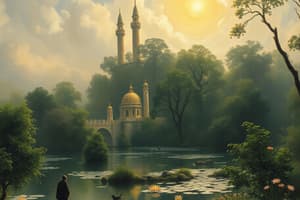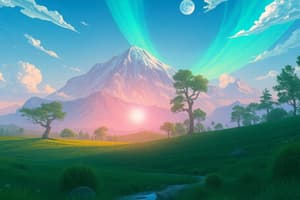Podcast
Questions and Answers
What is the scientific study of environmental components called?
What is the scientific study of environmental components called?
- Environmental Science (correct)
- Physical Biology
- Chemical Ecology
- Geological Studies
Which term refers to nonliving attributes in the environment?
Which term refers to nonliving attributes in the environment?
- Flora and Fauna
- Biological Factors
- Biotic Factors
- Abiotic Factors (correct)
What is the French origin of the word 'environment'?
What is the French origin of the word 'environment'?
- Environs (correct)
- Naturel
- Chimie
- Biologie
Which component is part of the biological environment?
Which component is part of the biological environment?
What defines 'the sum of all external conditions affecting the life, developments and survival of an organism'?
What defines 'the sum of all external conditions affecting the life, developments and survival of an organism'?
What is the biosphere?
What is the biosphere?
Which branch of environmental studies focuses on interactions between human beings and the environment?
Which branch of environmental studies focuses on interactions between human beings and the environment?
What is the lithosphere composed of?
What is the lithosphere composed of?
What is the main mineral constituent of soil?
What is the main mineral constituent of soil?
Where is the Earth's core located?
Where is the Earth's core located?
What is the thickness of the mantle?
What is the thickness of the mantle?
Which layer of the Earth contains basalt rich oceanic crust and granitic rich continental crust?
Which layer of the Earth contains basalt rich oceanic crust and granitic rich continental crust?
What percentage of the planet's surface is covered with water?
What percentage of the planet's surface is covered with water?
Which component of the lithosphere is responsible for the fertility of the soil?
Which component of the lithosphere is responsible for the fertility of the soil?
What percentage of the Earth's water is found in oceans and seas?
What percentage of the Earth's water is found in oceans and seas?
Apart from providing water, what other important function does the hydrosphere serve?
Apart from providing water, what other important function does the hydrosphere serve?
What is a significant contributor for the sustenance of life due to the hydrosphere?
What is a significant contributor for the sustenance of life due to the hydrosphere?
Flashcards are hidden until you start studying
Study Notes
Environmental Science
- Environmental Science is a branch of environmental studies that deals with the scientific study of environmental components, inherent or induced changes on organisms, and environmental hazards occurring due to human interactions with the environment.
The Environment
- The environment comes from the French word "environs", meaning "surroundings".
- It is defined as the sum of all external conditions affecting the life, developments, and survival of an organism.
- The environment includes everything, living or non-living, that surrounds us.
Environmental Components
- Physical Conditions (Physical Environment): non-living attributes like air, water, soil, climate, heat, light, noise, housing, radiations, and debris.
- Biological Factors (Biological Environment): include all types of flora, fauna, and micro-organisms.
The Biosphere
- The biosphere is a capsule encircling the earth's surface where all living things exist.
- It extends from 10,000 m below sea level to 6,000 m above sea level.
- Life forms do not exist outside this zone.
- The biosphere covers parts of the lithosphere, hydrosphere, and atmosphere.
The Lithosphere
- The lithosphere is the earth's crust, consisting of soil and rocks.
- The earth is an oblate spheroid, composed of the crust, mantle, and core.
- The core is around 7,000 kilometers in diameter, situated at the earth's center.
- The mantle surrounds the core, with a thickness of 2,900 kilometers.
- The crust floats on top of the mantle, composed of basalt-rich oceanic crust and granitic-rich continental crust.
- Soil is made up of inorganic and organic matter, water, and mineral constituents like oxides, silicates, and carbonates.
- Organic constituents, although forming only 4% to 6% of the lithosphere, are responsible for soil fertility and productivity.
The Hydrosphere
- The hydrosphere comprises all water resources, including surface and ground water.
- 71% of the planet's surface is covered with water.
- The hydrosphere is a vital part of the earth's life support module, providing water, air purification, temperature moderation, and waste assimilation.
- Water's excellent solvent nature is crucial for sustaining life.
- The world's water is found in oceans and seas, lakes and reservoirs, rivers and streams, glaciers and snowcaps, and ground water.
- Oceans and seas account for 96-97% of the world's water, while glaciers and polar icecaps account for 2-3%, and freshwater accounts for 5%.
Studying That Suits You
Use AI to generate personalized quizzes and flashcards to suit your learning preferences.




